Choosing the right human capital management (HCM) software for your company can be overwhelming. With a myriad of options promising to “revolutionize” your HR processes, how do you separate the truly transformative solutions from the overhyped ones?
Because of this, most HR leaders find themselves caught between basic HR tools that can’t scale and enterprise-grade systems that are overkill for their needs.
The challenge is finding a solution that not only streamlines current processes but also supports your company’s growth trajectory.
In this post, we examine 7 HCM software solutions tailored for mid-size and enterprise companies. We’ll focus on how each platform addresses key pain points like talent retention, workforce management and planning, and data-driven decision making.
- Fuel50
- Workday
- Oracle HCM Cloud
- BambooHR
- Paycor
- HR Cloud
- Rippling
Note: If you’re looking for a solution that combines advanced workforce planning with talent development and organizational agility, consider exploring Fuel50 in more depth. Our platform is designed to help enterprise companies unlock their workforce potential and drive organizational success. Request a demo now.
What to look for in HCM software?
Rather than jumping straight into feature comparisons, take a step back and articulate what you want to achieve with your HCM software.
Start by identifying your top HR pain points and aligning them with broader business objectives.
Are you struggling with employee retention? Is payroll processing consuming too much of your HR team’s time? Perhaps you’re finding it challenging to attract top talent in a competitive market.
By quantifying desired outcomes, such as reducing turnover by a specific percentage or cutting payroll processing time in half, you create a framework for evaluating different HCM solutions.
Once you’ve defined your goals, you can more effectively assess HCM features through this lens. Instead of being swayed by a long list of capabilities, focus on how each feature aligns with your prioritized objectives.
For instance, if improving employee performance and engagement is a key goal, pay close attention to performance management tools, learning and development modules, and employee self-service capabilities.
It’s also crucial to consider your company’s growth stage when evaluating human capital management HCM software. Early-stage companies might prioritize affordability and ease of use, while rapidly growing organizations need to emphasize scalability and comprehensive functionality.
Established companies might place more value on advanced analytics and strategic planning tools. Think about your company’s trajectory over the next three to five years to ensure the solution you choose can grow with you.
Implementation and integration considerations are often overlooked but can make or break the success of your HCM system. Assess how each potential solution will fit into your existing tech ecosystem.
Consider the complexity of employee data migration, the time and resources required for implementation, and the training needed for both HR professionals and employees. Remember, the true cost of an HCM system extends beyond the software itself to include these implementation factors.
Finally, when evaluating costs, look beyond the initial price tag to consider the total cost of ownership. This includes subscription fees, implementation costs, ongoing support and maintenance, and potential customization expenses.
However, don’t let cost be the sole deciding factor. Evaluate the ROI potential of each solution based on your defined goals. A more expensive system might be justified if it significantly advances your strategic HR objectives and drives overall business success.
Top 7 human capital management software solutions for mid-size and enterprise companies
Here are 7 of the best hcm software for enterprise companies.
Fuel50: Best for mid-size and enterprise companies seeking advanced talent management and internal mobility
-
Core functionalities: AI-powered talent marketplace, career pathing, skills development, internal mobility
-
Key integrations: Major human resource information system (HRIS) systems, learning management (LMS) platforms, applicant tracking system (ATS) solutions
-
Key differentiator: expert-driven skills ontology and personalized career development
-
Pricing: Custom pricing based on company size and selected modules
At Fuel50, we’ve developed a solution that complements core HCM software systems by focusing on advanced talent management. Our platform is designed to address the critical challenges of skills gaps and internal mobility that many mid-size companies face today.
We recognize that while most mid-size companies already have core HCM systems in place, these systems often fall short when it comes to strategic talent development and internal mobility. That’s where Fuel50 comes in.
Our solution integrates with existing human resource management infrastructure to provide advanced capabilities in career pathing, skills development, and internal talent marketplace functionality.
Here’s what that means in more detail.
Increase internal mobility and talent utilization with our talent marketplace
Unlike traditional HCM systems that often silo employees within their current roles, the Fuel50 platform uses advanced algorithms to identify hidden talents and potential.
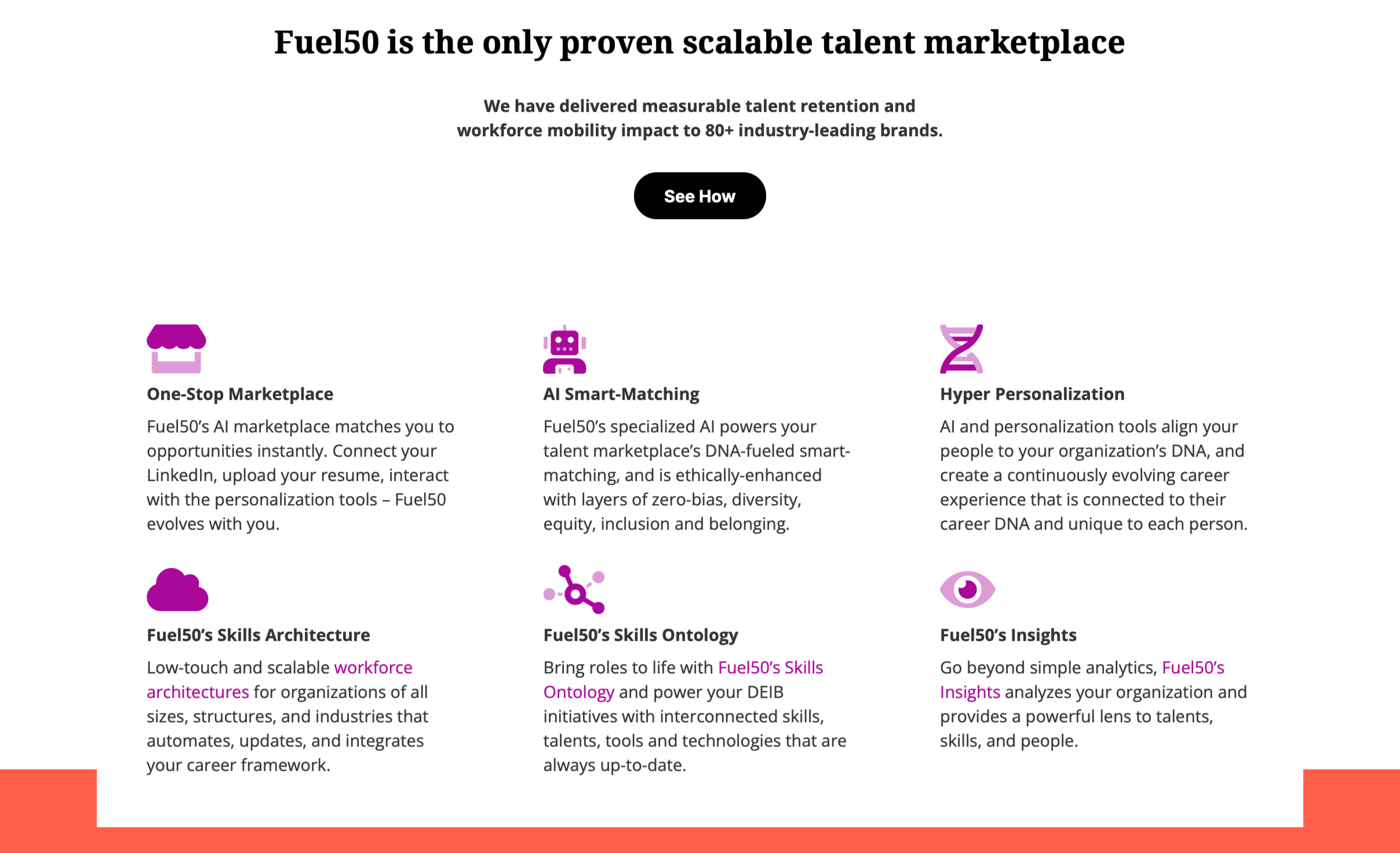
The platform analyzes not just an employee’s current skills, but their adjacent skills, interests, and career aspirations.
This comprehensive approach makes it possible to suggest opportunities that employees might not have considered, fostering unexpected career moves that benefit both the individual and the organization.
Our gig assignment functionality is particularly powerful if you’re a mid-size company looking to maximize your existing talent.
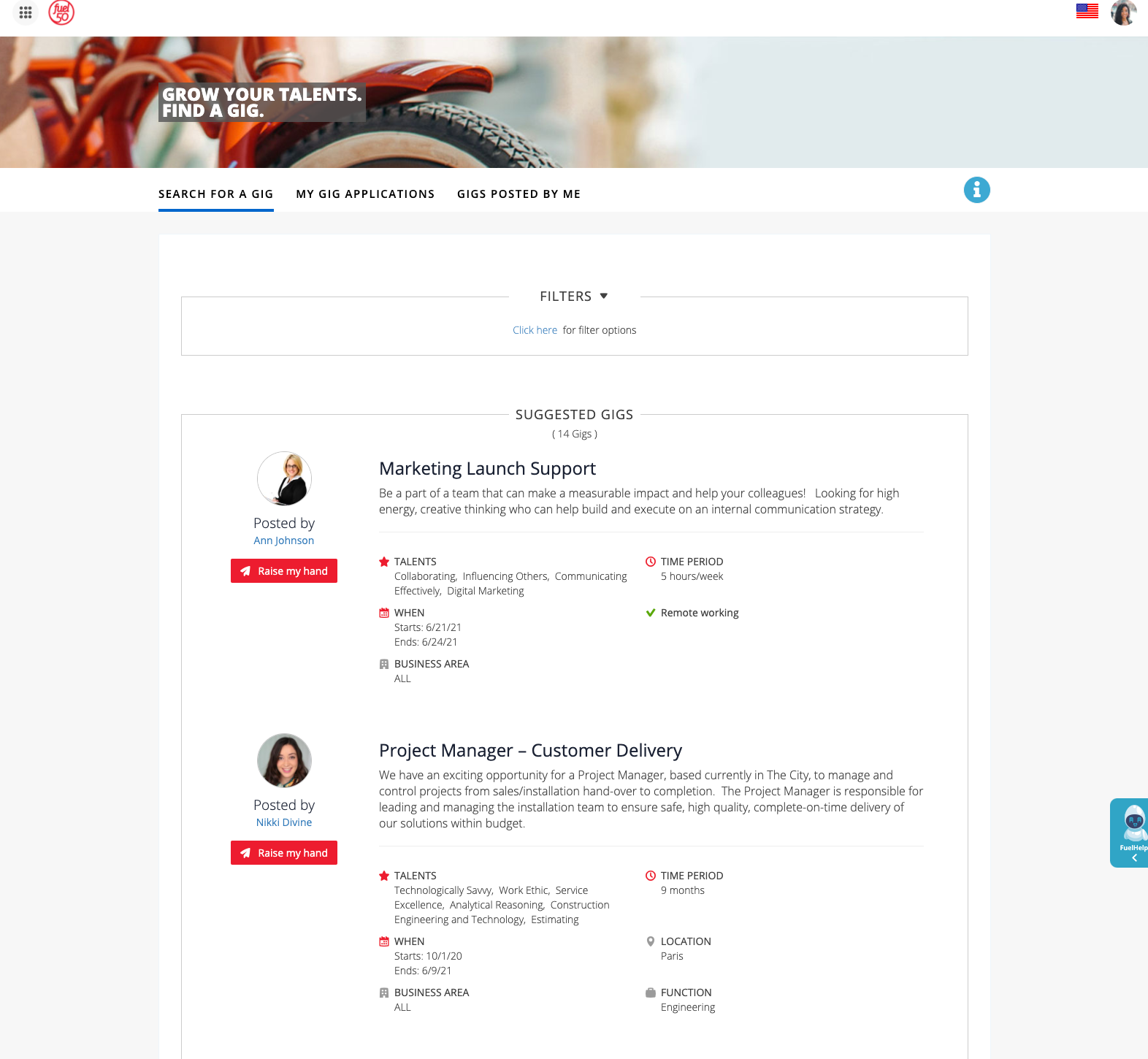
While many HCM systems struggle to facilitate short-term, cross-departmental assignments, our platform makes this process seamless. We’ve seen clients reduce external contractor costs by leveraging internal talent for project-based work.
Moreover, our talent marketplace adapts in real-time to your organization’s changing needs. As new projects or roles emerge, our tool immediately starts identifying potential internal candidates, allowing you to respond to market changes with an agility that larger competitors often lack.
Transform employee experience and boost retention with personalized career journeys
We’ve moved beyond the outdated “annual review and development plan” model still used by many HCM systems. Fuel50 provides your employees with insights into their career potential.
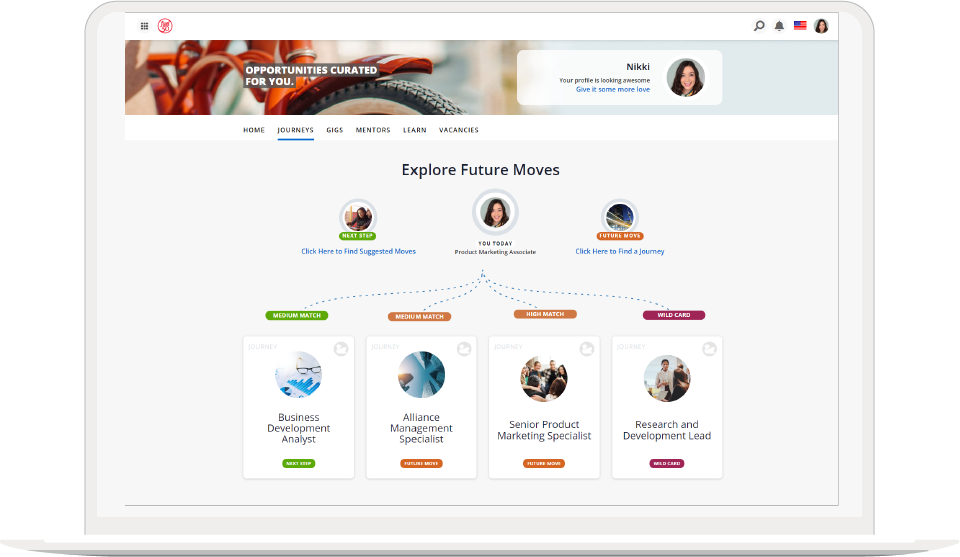
We offer personalized skills assessments, learning recommendations, and career path visualizations that are updated in real-time based on the employee’s progress and organizational needs. This level of personalization and immediacy is rarely found in standard HCM suites.
What sets us apart is our focus on empowering employees to drive their own development. While many systems relegate career planning to an HR-driven process, we put powerful tools directly in employees’ hands. They can explore potential career paths, understand skill gaps, and take immediate action to progress their careers.
Transform your workforce with our dynamic skills ontology
While most HCM systems offer a fixed set of skills, our team of I/O psychologists continuously updates our ontology, incorporating emerging skills and industry-specific competencies in real-time.
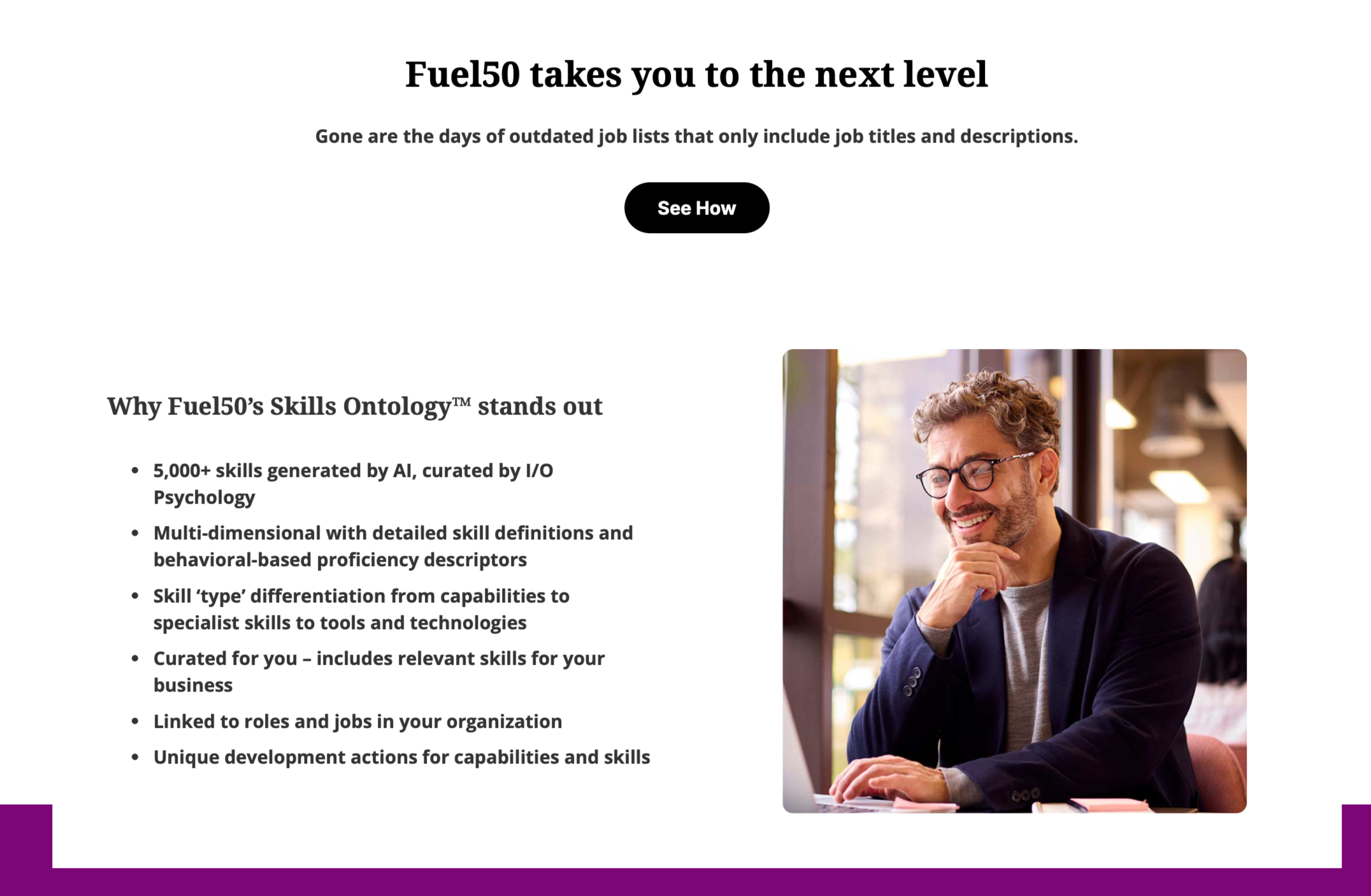
Our system maps relationships between skills, identifying adjacent and transferable competencies. This gives you a fuller picture of your workforce’s capabilities, often revealing talent you didn’t know you had.
We also connect skills directly to your business outcomes. Unlike typical HCM systems that treat skills as isolated HR data, we link them to your key performance indicators. This means you can see exactly how your workforce’s skills impact your bottom line.
On top of that, our ontology drives actionable insights. We don’t just show you skill gaps; we help you predict and prevent them. The platform analyzes industry trends and your company’s unique needs to forecast future skill requirements, allowing you to stay ahead of the curve.
In practical terms, this means faster identification of skill gaps, more effective talent deployment, and data-driven decisions about skill development that directly impact business results.
Enhance your existing HR systems without disruption
Fuel50 doesn’t replace your current HR tech stack, it amplifies it. Our platform integrates with your existing HRIS, ATS, and LMS systems, adding advanced talent management capabilities without the need for a complete overhaul.
Key benefits of our integration approach:
- Unified talent view: Our platform acts as a central hub, bringing together disparate HR data and employee records to provide a holistic view of your workforce’s skills, experiences, and potential.
- Enhanced analytics: We feed our talent insights directly into your existing reporting tools, giving you deeper workforce analytics without requiring new software.
Note: If you’re looking for a solution that combines advanced workforce planning with talent development and organizational agility, consider exploring Fuel50 in more depth. Our platform is designed to help mid-size companies unlock their workforce potential and drive organizational success. Request a demo now.
Paycor: Best HCM for mid-size companies prioritizing ease of use and actionable insights
-
Short overview: Paycor is particularly well-suited for mid-size companies looking to streamline their HR processes without a steep learning curve. While it may not offer the extensive customization of some enterprise-grade systems, its balance of functionality and usability makes it a strong contender in the mid-size HCM market.
-
Core functionalities: Payroll, HR, talent management, workforce management, benefits administration
-
Key integrations: QuickBooks, Xero, Sage Intacct, various applicant tracking systems
-
Key differentiator: Streamlined user experience with actionable analytics
-
Pricing: Custom quotes based on company size and selected modules
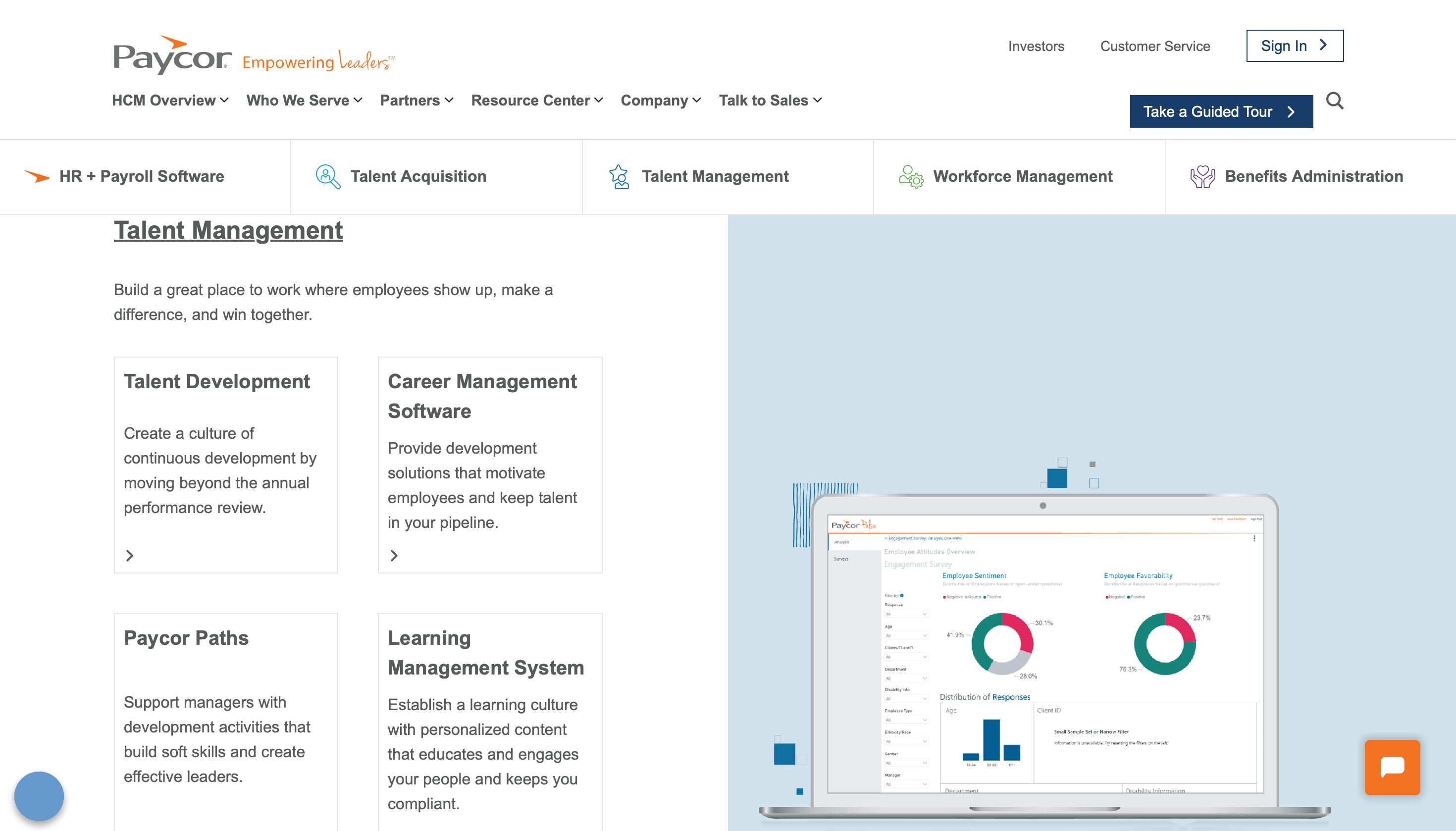
Paycor stands out in the HCM market by focusing on simplicity without compromising functionality.
While competitors like Workday and Oracle offer extensive feature lists, Paycor prioritizes ease of use, making it particularly suitable for mid-size companies without large HR tech teams.
The platform’s interface is notably intuitive, reducing the learning curve for HR professionals and employees alike.
This simplicity doesn’t come at the cost of capability, however. Paycor’s payroll system, for example, handles complex tasks like multi-state tax calculations efficiently, rivaling more complex systems like ADP but with less overwhelming options.
In talent management, Paycor offers a suite that’s well-tailored for mid-size businesses. Unlike SAP SuccessFactors, which can feel oversized for smaller organizations, Paycor provides comprehensive tools from recruitment to performance management that scale appropriately with company growth.
A key strength of Paycor is its analytics capabilities. Although many HCM systems treat reporting as a secondary feature, Paycor emphasizes actionable insights. The platform provides clear, useful data analysis that helps inform decision-making, a feature that sets it apart from many competitors in the mid-size market.
Pros:
-
Highly intuitive user interface suitable for users with varied tech skills
-
Efficient payroll system that handles complex calculations
-
Scalable talent management suite appropriate for mid-size companies
-
Strong focus on actionable analytics and reporting
Cons:
-
Pricing may be higher compared to some competitors
-
Limited customization options for more complex organizational needs
-
Inconsistent customer support quality
BambooHR: Best for SMBs looking for an all-in-one HR solution
-
Short overview: BambooHR is particularly well-suited for growing companies that need a comprehensive HR solution without the complexity of enterprise systems.
-
Key features: HRIS, applicant tracking, onboarding, time tracking, performance management, employee satisfaction
-
Key integrations: Slack, Trello, Google Calendar, Zapier, various payroll providers
-
Key differentiator: Exceptional user experience and employee self-service capabilities
-
Pricing: Essentials plan and Advantage plan, custom pricing based on number of employees

BambooHR positions itself as a comprehensive, user-friendly HR platform for growing companies. Unlike enterprise-focused solutions like Workday or Oracle, BambooHR caters specifically to the needs of small to mid-size businesses, offering a balance of simplicity and functionality.
The platform’s standout feature is its intuitive interface and robust employee self-service options. While competitors like Paycor also prioritize user experience, BambooHR takes it a step further by empowering employees to manage their own information, time off, and benefits. This self-service approach significantly reduces the administrative burden on HR teams, a crucial factor for smaller organizations with limited resources.
BambooHR’s applicant tracking system (ATS) is noteworthy for its seamless integration with the core HRIS. Unlike standalone ATS solutions or even some all-in-one platforms, BambooHR offers a smooth transition from candidate to employee, streamlining the hiring and onboarding process. This integration is particularly valuable for fast-growing companies managing frequent hiring cycles.
The platform’s performance management tools, while not as extensive as specialized solutions like 15Five, offer a good balance for mid-size companies. BambooHR focuses on continuous feedback and goal-setting rather than complex performance metrics, aligning well with modern performance management trends.
One area where BambooHR stands out is its emphasis on employee satisfaction. The platform includes built-in employee Net Promoter Score (eNPS) surveys, a feature often overlooked by competitors in the mid-size market. This focus on employee experience can be a significant advantage for companies prioritizing retention and engagement.
Pros:
-
Exceptionally user-friendly interface for both HR professionals and employees
-
Strong employee self-service capabilities
-
Well-integrated applicant tracking and onboarding modules
-
Built-in employee satisfaction measurement tools
-
Flexible integration options with popular business tools
Cons:
-
Limited advanced features compared to enterprise-level solutions
-
Payroll is not included in the core offering, requiring integration with third-party providers
-
Reporting capabilities, while adequate for most needs, may not satisfy companies requiring in-depth analytics
-
Pricing can be higher than some basic HRIS solutions, though justified by the feature set
Oracle Cloud HCM: Best for companies that are looking for a 360-solution that encompasses workforce management and performance management
-
Short overview: It offers the functionality of an enterprise-grade system with the flexibility of a cloud solution, making it a strong choice for organizations that prioritize comprehensive features and scalability over simplicity.
-
Core functionalities: Core HR, payroll, talent management, workforce management, HR analytics, AI-driven insights
-
Key integrations: Oracle ERP Cloud, Oracle CX Cloud, Taleo, Workday, SAP
-
Key differentiator: Comprehensive suite with advanced AI and machine learning capabilities
-
Pricing: Custom pricing based on modules and company size, typically higher-end for mid-market solutions
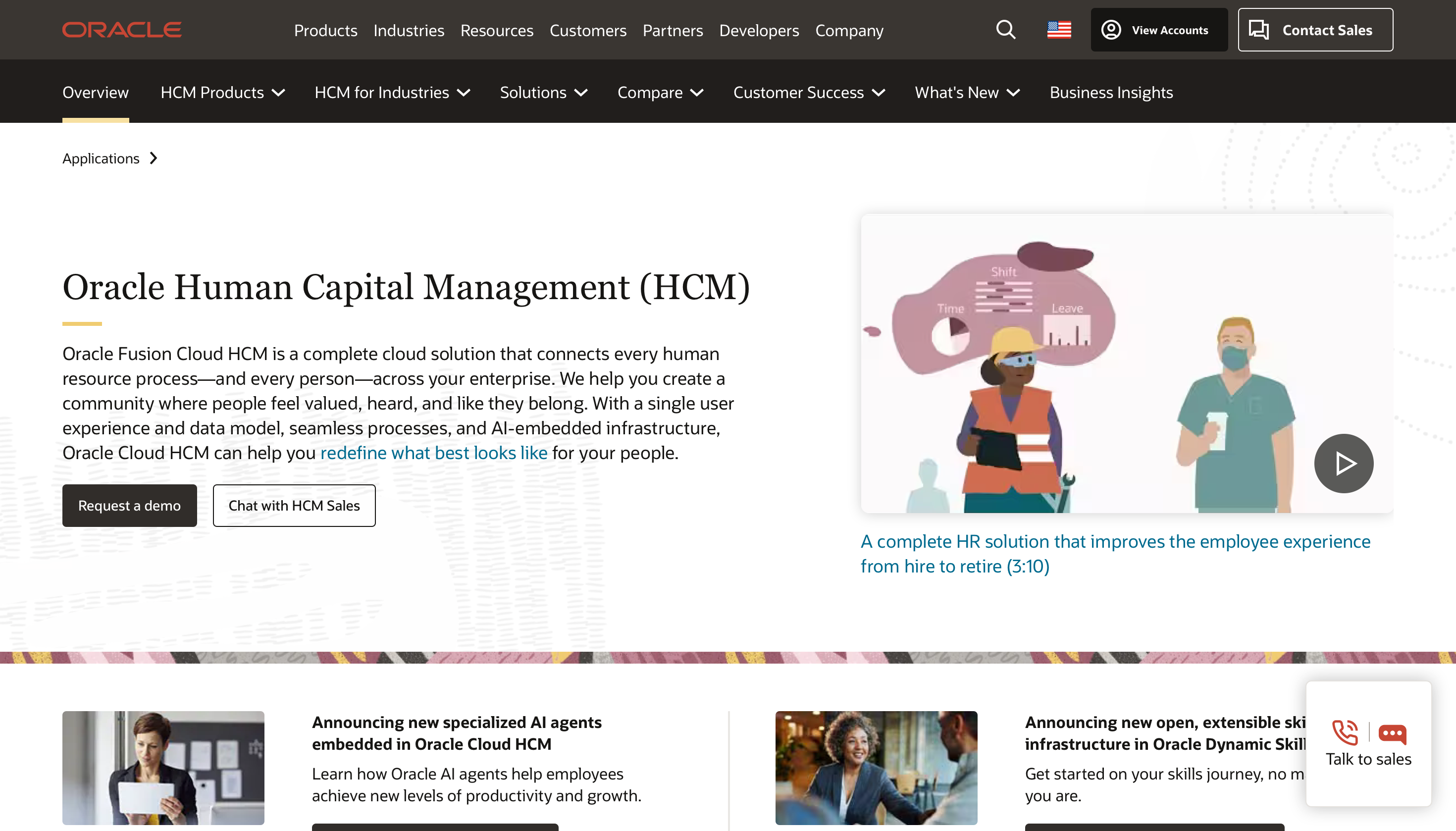
Oracle Fusion Cloud HCM stands out as a robust, enterprise-grade solution that’s increasingly targeting the upper end of the mid-market. Unlike more streamlined options like BambooHR or Paycor, Oracle offers a depth of functionality that can rival or exceed dedicated point solutions in areas like payroll or talent management.
The platform’s key strength lies in its comprehensive nature. While competitors might excel in specific areas, Oracle provides a unified system for all HR functions. This integration is particularly valuable for companies dealing with complex organizational structures or planning significant growth.
Oracle’s investment in AI and machine learning sets it apart in the mid-market HCM space. Features like AI-recommended learning content or predictive analytics for workforce planning are more advanced than what’s typically offered by mid-market focused competitors. This can be a significant advantage for companies looking to leverage data for strategic HR decisions.
The global capabilities of Oracle Cloud HCM are noteworthy. Unlike some mid-market solutions that struggle with multi-country support, Oracle offers robust localization for payroll and compliance across numerous countries. This makes it an attractive option for mid-size companies with international operations or expansion plans.
However, Oracle’s enterprise roots are evident in its complexity. While efforts have been made to improve user experience, it still presents a steeper learning curve compared to more user-friendly options like BambooHR. The implementation process can also be more involved and time-consuming than with simpler systems.
Pros:
-
Comprehensive functionality covering all major HR areas
-
Advanced AI and machine learning capabilities
-
Strong employee self-service capabilities
-
Strong global payroll and compliance features
-
Robust reporting and analytics tools
-
Scalability to support significant company growth
Cons:
-
Higher complexity and potential learning curve
-
Can be overkill for companies with simpler HR needs
-
Generally higher cost compared to mid-market focused solutions
-
Implementation can be lengthy and resource-intensive
HR Cloud: Best for companies seeking customizable, employee-centric HR solutions
-
Short overview: HR Cloud offers a good balance of functionality and flexibility, making it an attractive option for organizations that find enterprise solutions too rigid and basic HRIS systems too limited.
-
Core functionalities: Employee engagement, onboarding, performance management, payroll, benefits administration, applicant tracking
-
Key integrations: ADP, QuickBooks, BambooHR, Slack, Google Workspace, Office 365
-
Key differentiator: Highly customizable platform with strong focus on employee experience
-
Pricing: Modular pricing based on selected features and number of employees
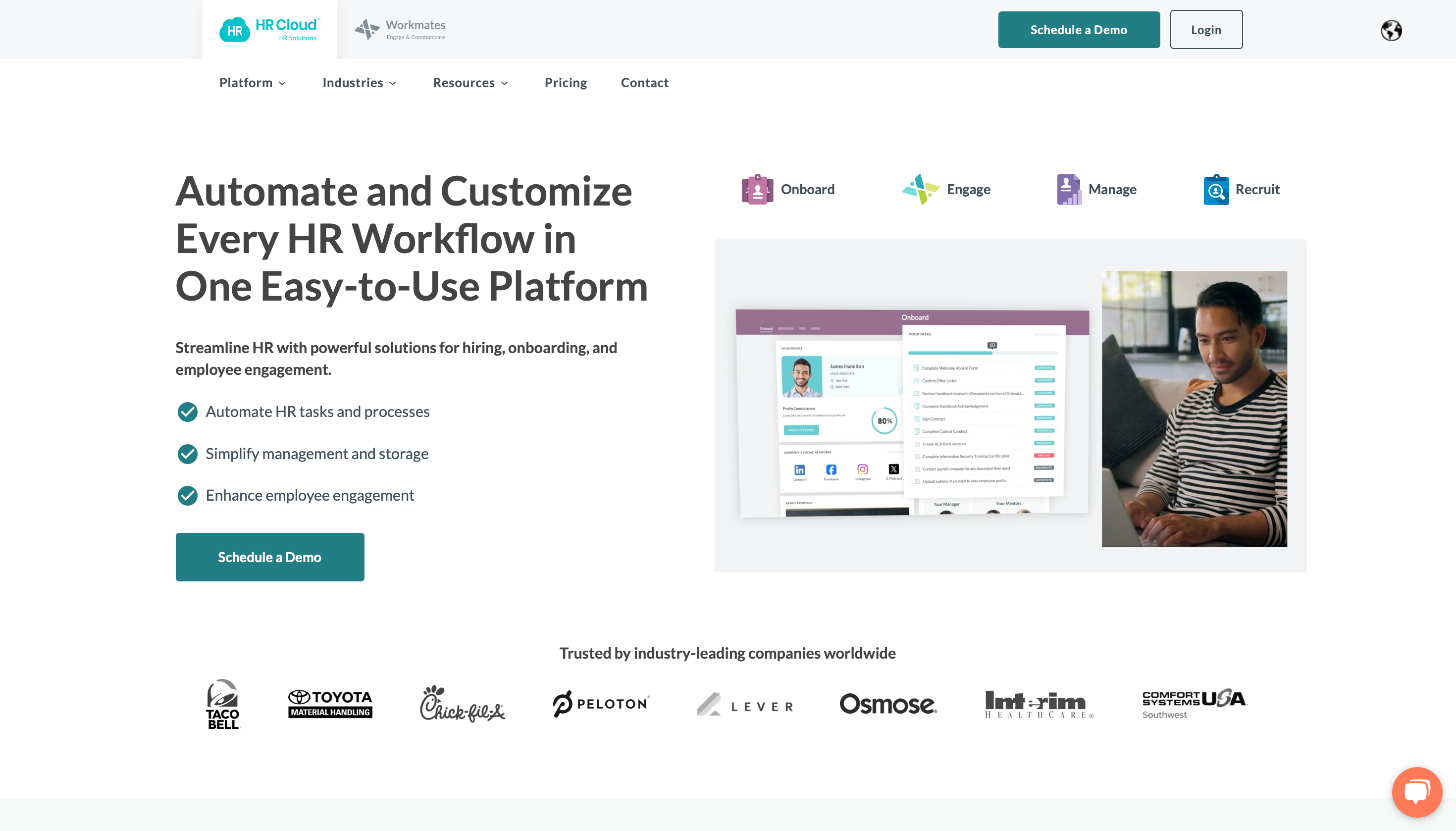
HR Cloud positions itself as a flexible, employee-centric solution for mid-size companies. Unlike more rigid systems like Oracle or SAP, HR Cloud offers a high degree of customization, allowing companies to tailor the platform to their specific needs and branding.
The platform’s standout feature is its emphasis on employee experience. While competitors like Workday also focus on this area, HR Cloud takes it further with its Workmates social collaboration tool. This feature fosters employee engagement and communication in a way that many mid-market HCM solutions don’t address.
HR Cloud’s onboarding module is particularly strong, offering a more comprehensive approach than many competitors in the mid-market space. It includes features like video introductions, task management, and social integration, creating a more engaging experience for new hires.
The platform’s modular approach to pricing and functionality sets it apart from all-or-nothing solutions. This allows mid-size companies to start with core features and expand as needed, providing more flexibility than enterprise-focused systems that often require full-suite implementations.
However, HR Cloud’s customizability can be a double-edged sword. While it allows for tailored solutions, it may require more initial setup and ongoing management compared to more out-of-the-box solutions like BambooHR.
Pros:
-
Highly customizable to fit specific company needs and branding
-
Strong focus on employee engagement and experience
-
Comprehensive onboarding module
-
Flexible, modular pricing structure
-
Good balance of features for mid-size companies
Cons:
-
Customization may require more initial setup and ongoing management
-
Some users report a steeper learning curve due to the platform’s flexibility
-
Analytics capabilities, while adequate, may not be as advanced as some competitors
-
Customer support quality can be inconsistent
Workday: Best for companies who prioritize analytics and integrations
-
Short overview: Workday particularly valuable for organizations that prioritize advanced analytics, require strong financial integration, or have complex organizational structures.
-
Core functionalities: HRIS, talent management, payroll, time tracking, recruiting, learning management, workforce planning, analytics
-
Key integrations: Salesforce, Microsoft Office 365, Google Workspace, Slack, ServiceNow, various ATS and learning platforms
-
Key differentiator: Unified HCM and financial management system with advanced analytics and AI capabilities
-
Pricing: Custom pricing based on company size and selected modules, typically higher-end for mid-market solutions
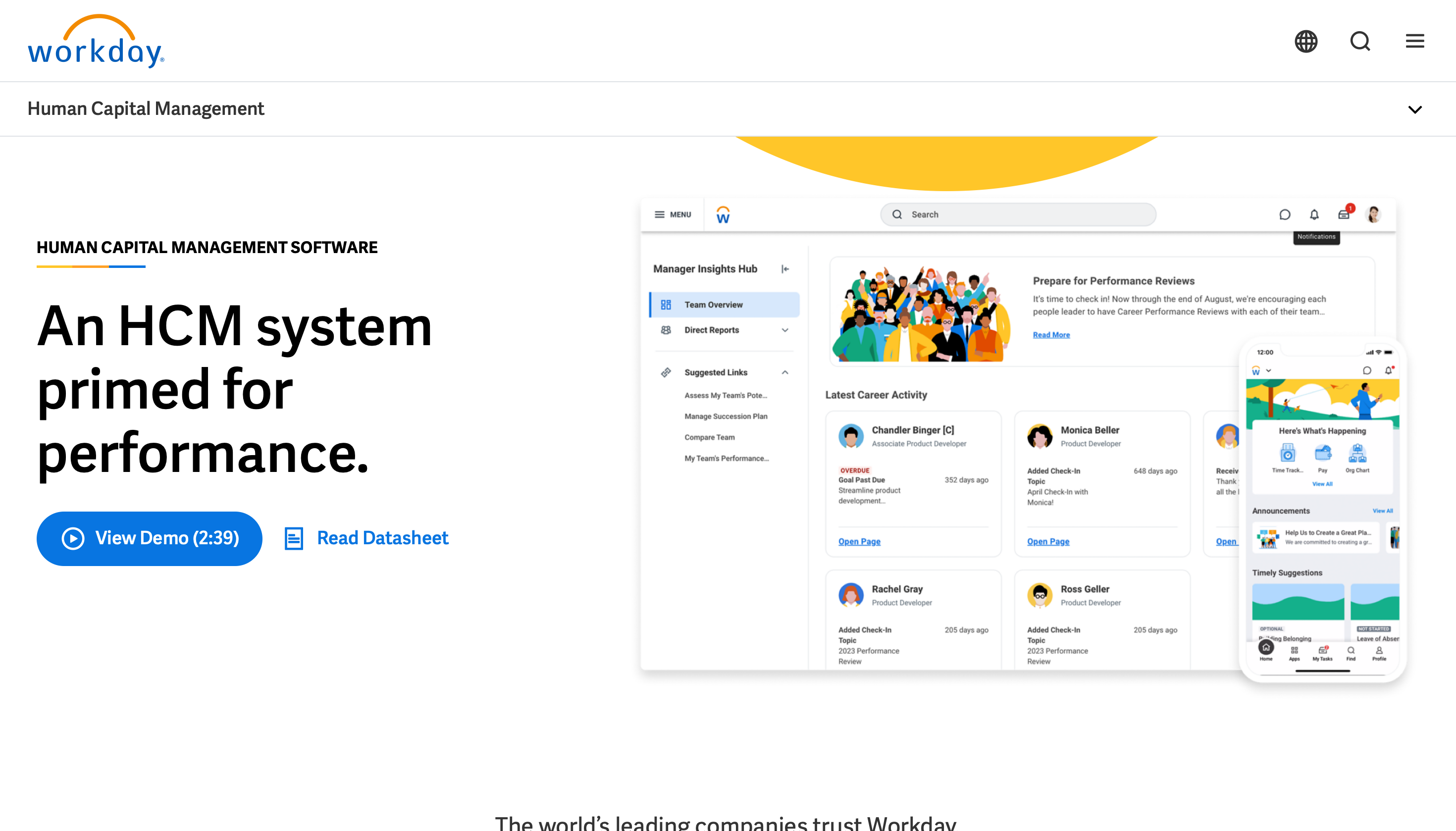
Workday positions itself as a comprehensive, cloud-based HCM solution that brings enterprise-level capabilities to the mid-market. Unlike more focused solutions like BambooHR or Rippling, Workday offers a deeply integrated system that combines HCM with financial management.
The platform’s standout feature is its unified approach to HR and finance. While competitors like Oracle also offer this integration, Workday’s implementation is often considered more seamless. This integration allows for more accurate workforce planning and budgeting, providing mid-size companies with insights typically reserved for larger enterprises.
Workday’s analytics capabilities are particularly strong. The platform offers more advanced reporting and predictive analytics compared to many mid-market competitors. Its machine learning-driven insights can help companies make data-driven decisions about workforce trends, skills gaps, and succession planning.
The system’s flexibility in handling complex organizational structures sets it apart from many mid-market solutions. This makes Workday particularly suitable for mid-size companies with multiple entities, diverse employee types, or plans for significant structural changes or growth.
However, Workday’s enterprise-grade capabilities come with increased complexity. The implementation process can be more involved and time-consuming compared to simpler HCM solutions. Additionally, the platform may require dedicated resources to fully leverage its extensive features.
Pros:
-
Comprehensive HCM functionality with strong financial management integration
-
Advanced analytics and AI-driven insights
-
Highly configurable to handle complex organizational structures
-
Regular updates and innovations through cloud delivery
-
Strong mobile capabilities
Cons:
-
Higher complexity and potential for a steeper learning curve
-
Typically more expensive than mid-market focused solutions
-
Implementation can be lengthy and resource-intensive
-
May offer more functionality than needed for some mid-size companies
Rippling: Best for companies seeking unified HR, IT, and Finance management
-
Short overview: Rippling’s unified approach and powerful automation capabilities make it an excellent choice for organizations that value efficiency and are willing to invest time in leveraging a more complex, feature-rich platform.
-
Core functionalities: HRIS, payroll, benefits administration, talent management, time tracking, IT management, expense management
-
Key integrations: Slack, Zoom, DocuSign, QuickBooks, NetSuite, Salesforce, and 500+ apps
-
Key differentiator: Unified platform for HR, IT, and finance operations with extensive automation capabilities
-
Pricing: Modular pricing starting at $8 per user per month, with custom quotes for full-service plans
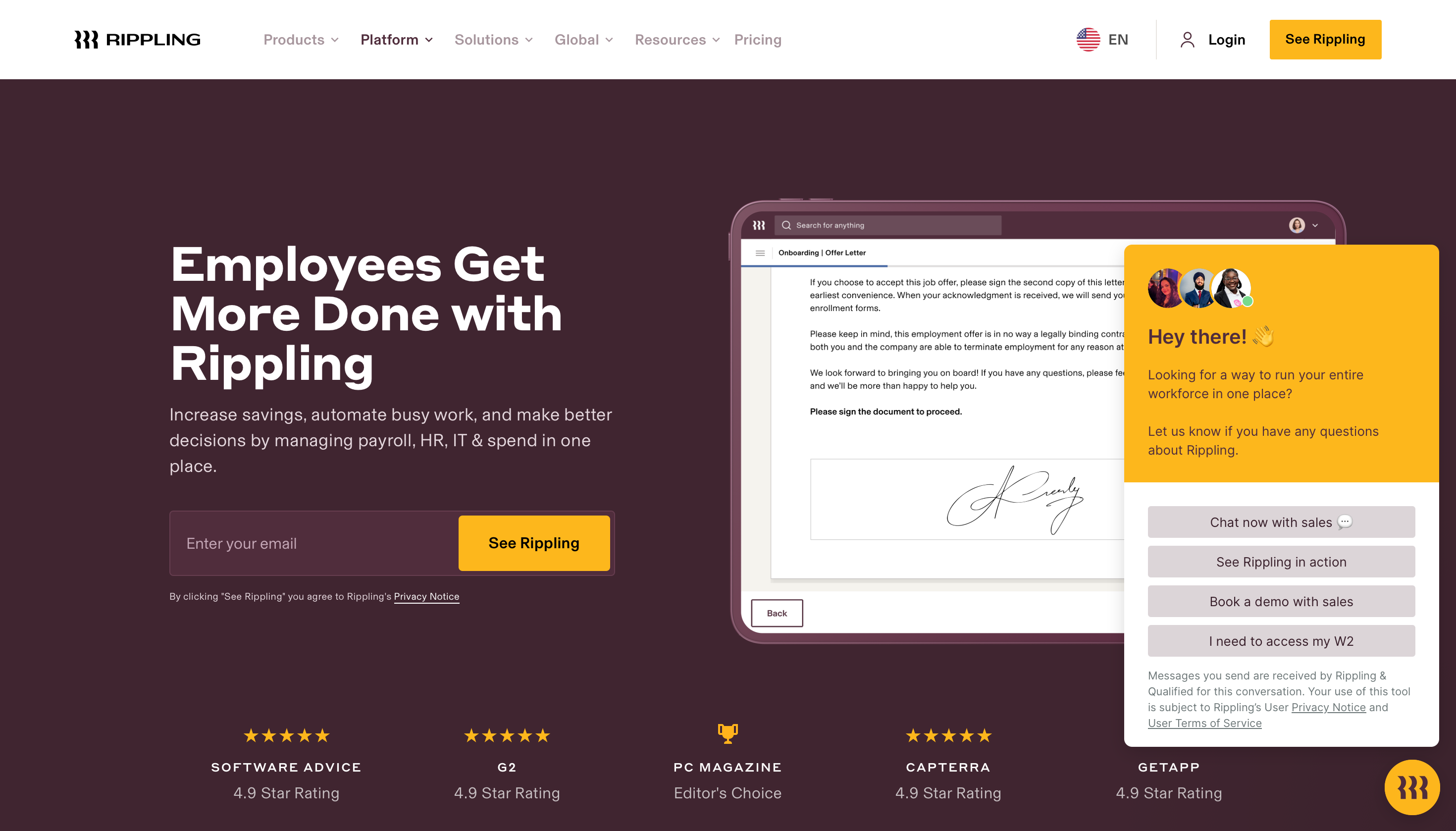
Rippling stands out in the mid-market HCM space by offering a uniquely comprehensive platform that extends beyond traditional HR functions. Unlike competitors like BambooHR or Paycor that focus primarily on HR, Rippling integrates HR, IT, and finance management into a single system.
This unified approach addresses a common pain point for mid-size companies: the disconnect between HR and IT processes. While other HCM solutions might require separate systems for tasks like employee onboarding and equipment provisioning, Rippling handles both seamlessly. This integration can significantly streamline operations, especially for companies with remote or distributed workforces.
Rippling’s automation capabilities are particularly noteworthy. The platform offers more extensive and sophisticated automation options compared to many mid-market competitors. This includes complex workflows that can span across HR, IT, and finance departments, potentially reducing administrative workload more effectively than standalone HR systems.
The platform’s global capabilities are also strong, offering support for international hiring and payroll that rivals larger enterprise solutions like Oracle or SAP. This makes Rippling an attractive option for mid-size companies with global operations or expansion plans.
However, Rippling’s broad feature set can be a double-edged sword. While it offers comprehensive functionality, it may present a steeper learning curve compared to more focused HR solutions. The platform’s power users can benefit greatly from its extensive capabilities, but casual users might find it overwhelming.
Pros:
-
Unified platform for HR, IT, and finance operations
-
Extensive automation capabilities across departments
-
Strong support for global hiring and payroll
-
Large app integration ecosystem
-
Flexible, modular pricing structure
Cons:
-
Potential complexity due to the breadth of features
-
May be overkill for companies seeking a simple HRIS solution
-
Some users report occasional glitches with certain integrations
-
Pricing can add up quickly when adding multiple modules
Choosing the right HCM software for your mid-size or enterprise company
As you evaluate these options, consider:
- Which features are critical for your current HR processes and future growth plans?
- How well does each platform align with your company culture and employee expectations?
- What level of scalability and flexibility do you need as your organization evolves?
While comprehensive HCM suites like Workday or Oracle offer end-to-end solutions, they may be complex for some mid-size companies. On the other hand, more focused platforms like BambooHR or Paycor provide streamlined experiences but might lack advanced features.
But if you’re seeking to enhance specific areas of talent management without overhauling your entire HR tech stack, Fuel50 offers a compelling alternative. By focusing on critical aspects such as career development, internal mobility, and skills management, Fuel50 complements existing HCM systems to create a more dynamic and engaged workforce.
Note: If you’re looking for a solution that combines advanced workforce planning with talent development and organizational agility, consider exploring Fuel50 in more depth. Our platform is designed to help mid-size companies unlock their workforce potential and drive organizational success. Request a demo now.


